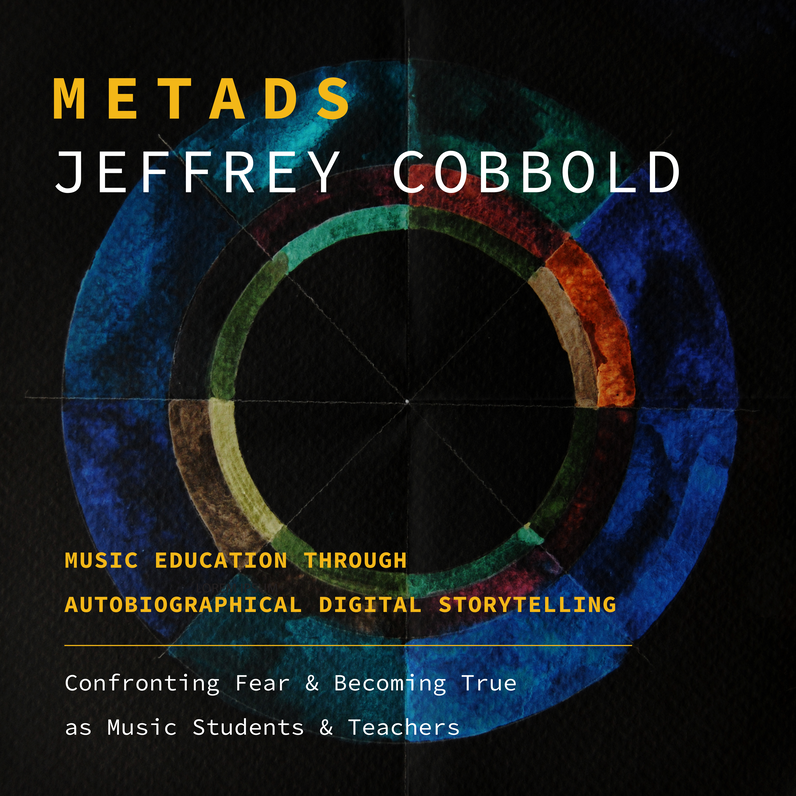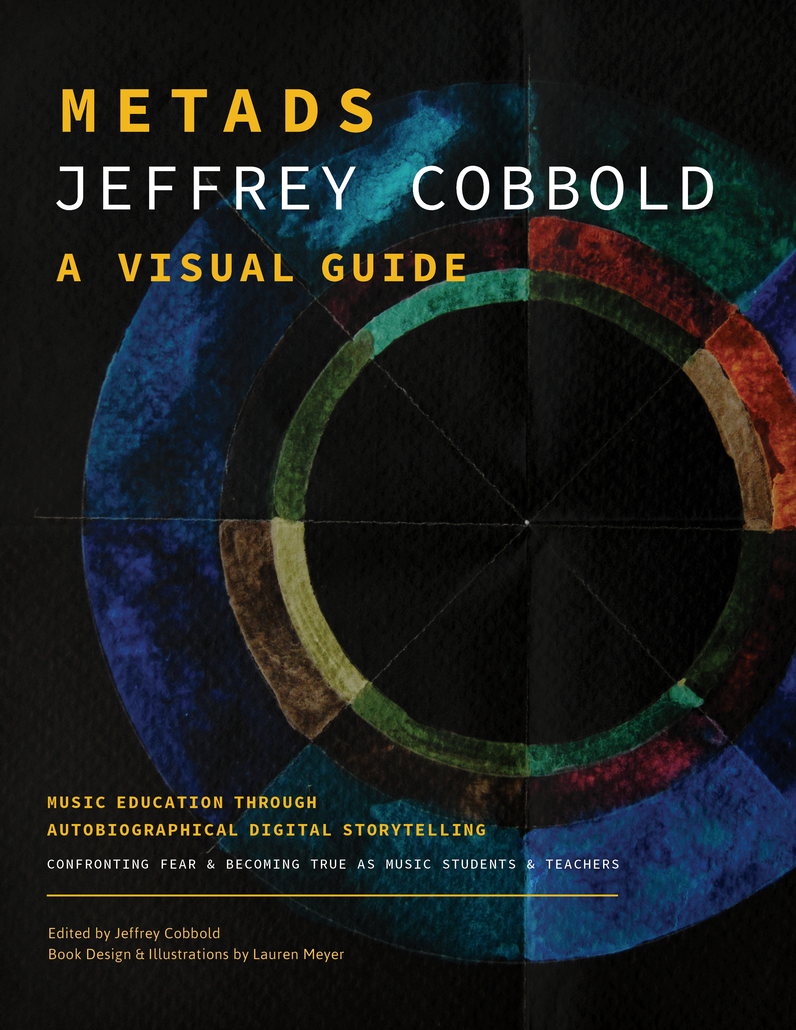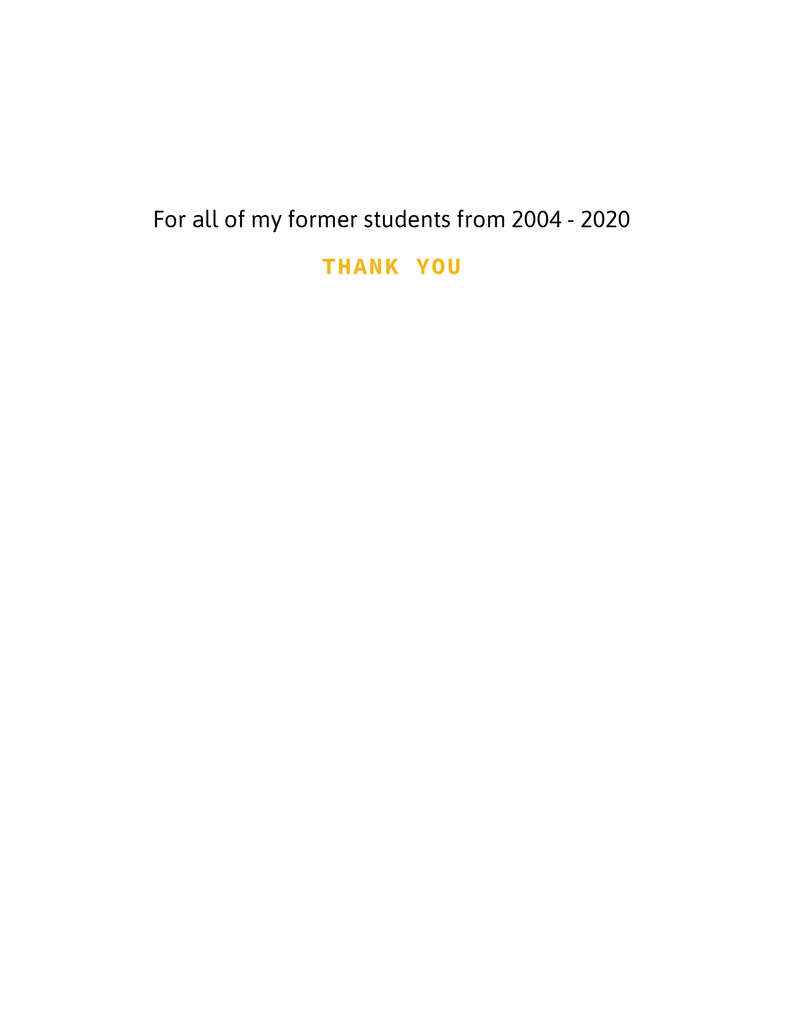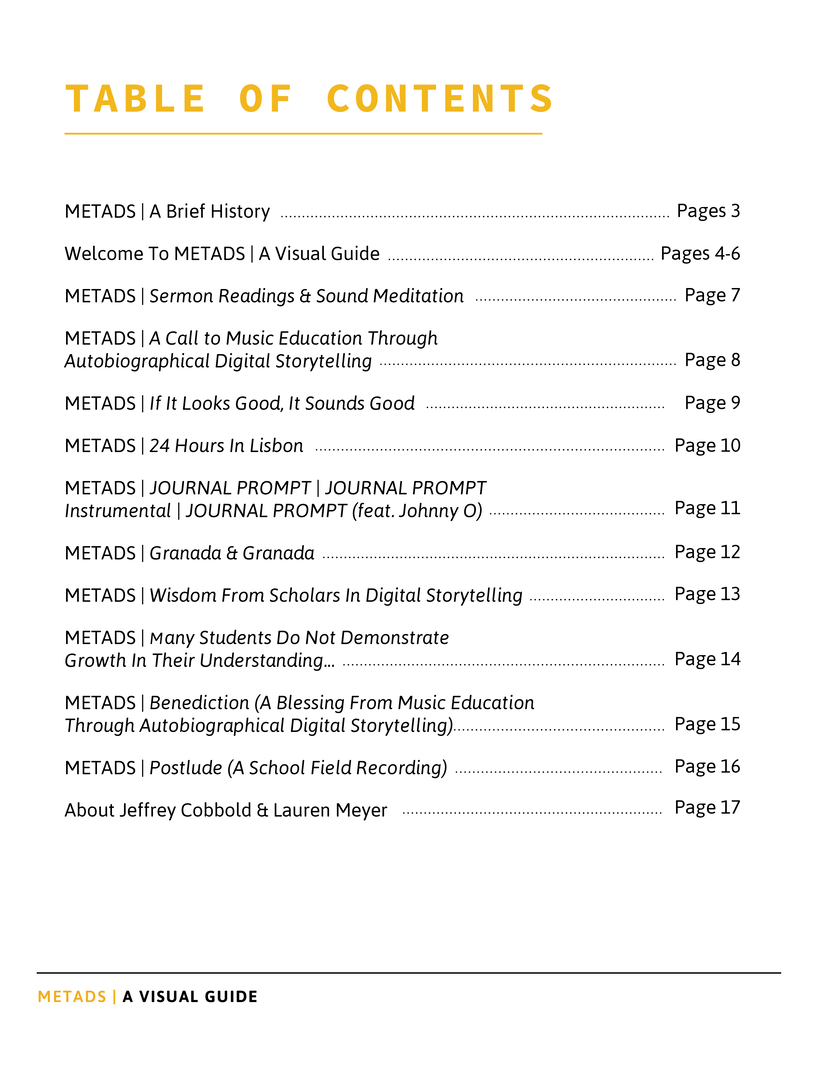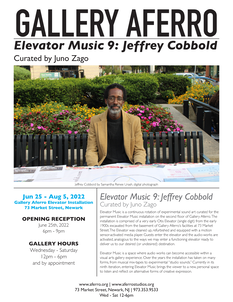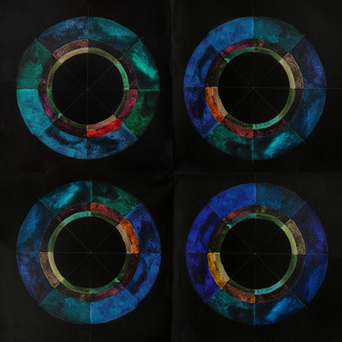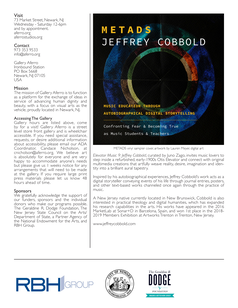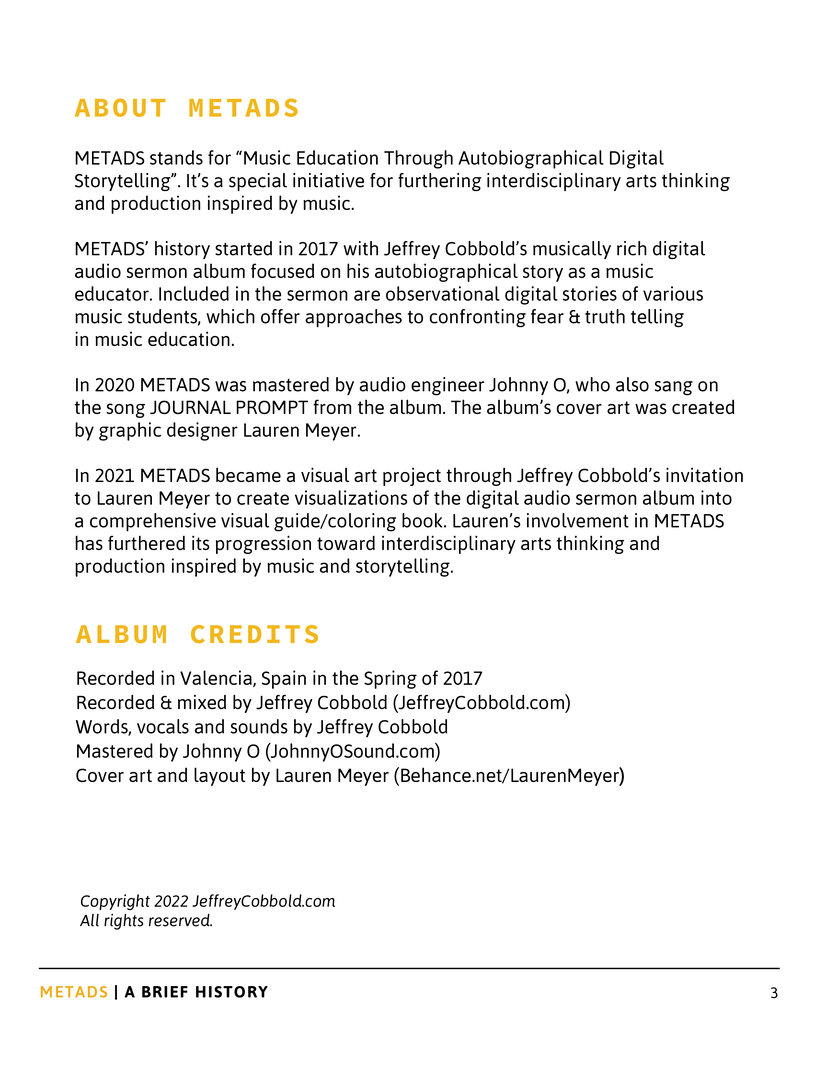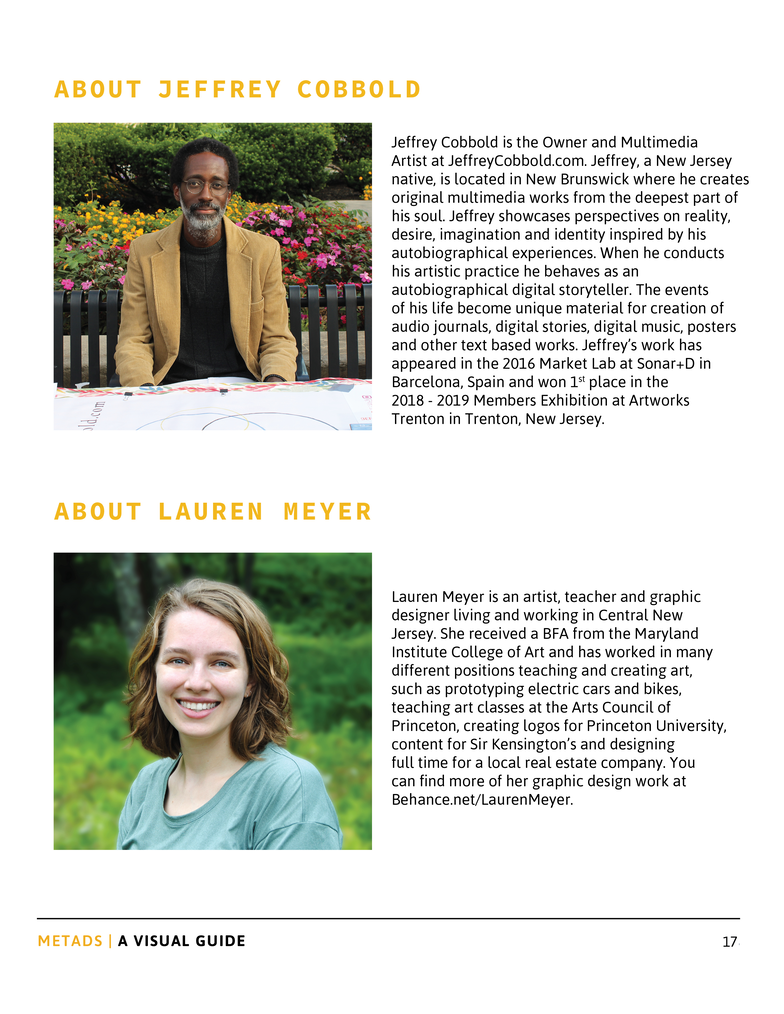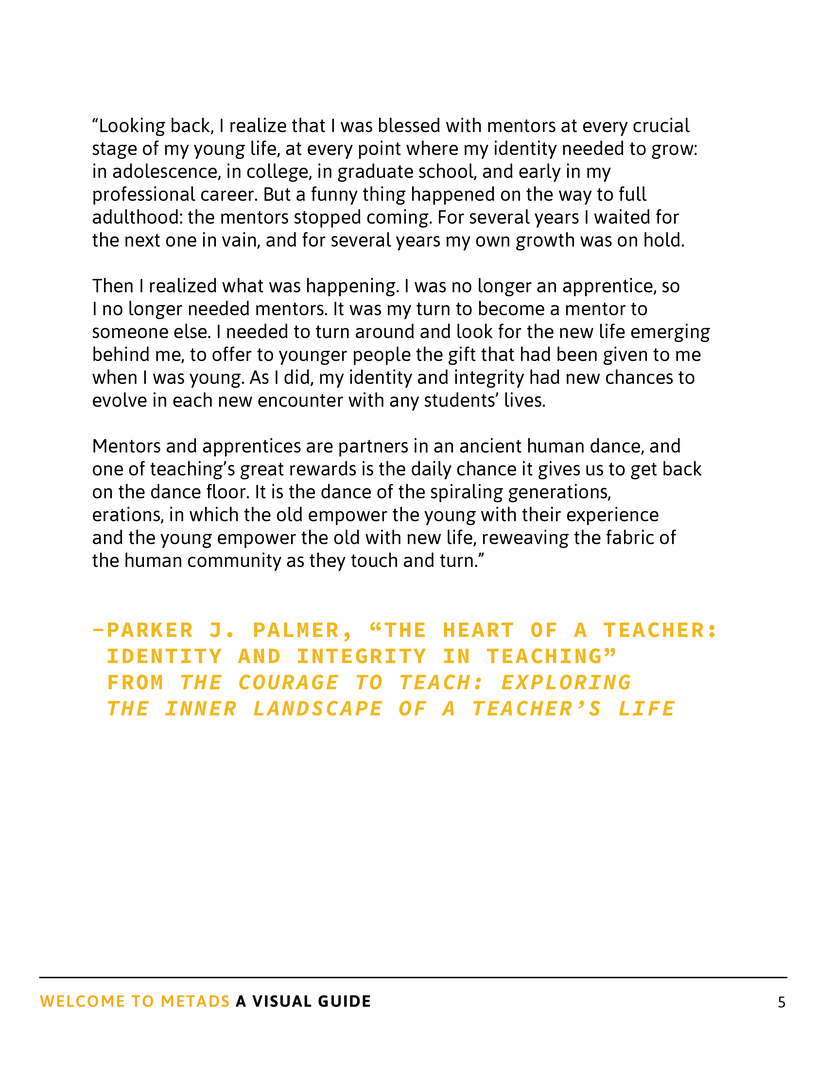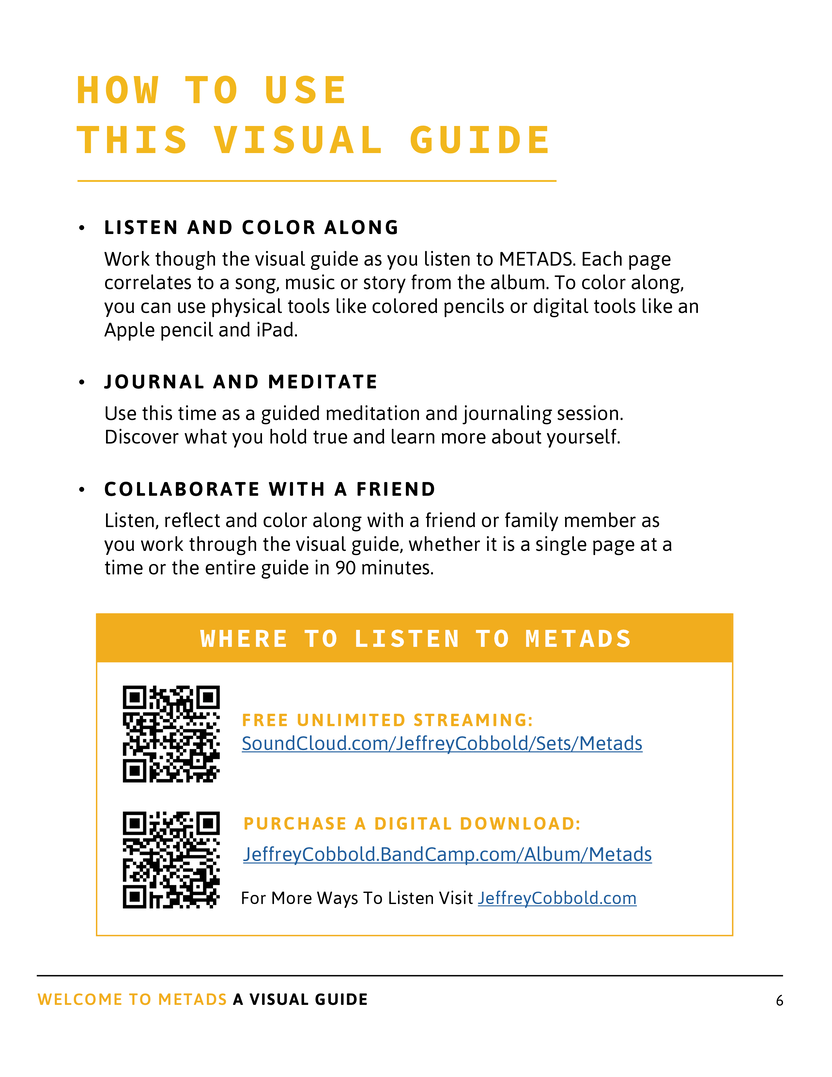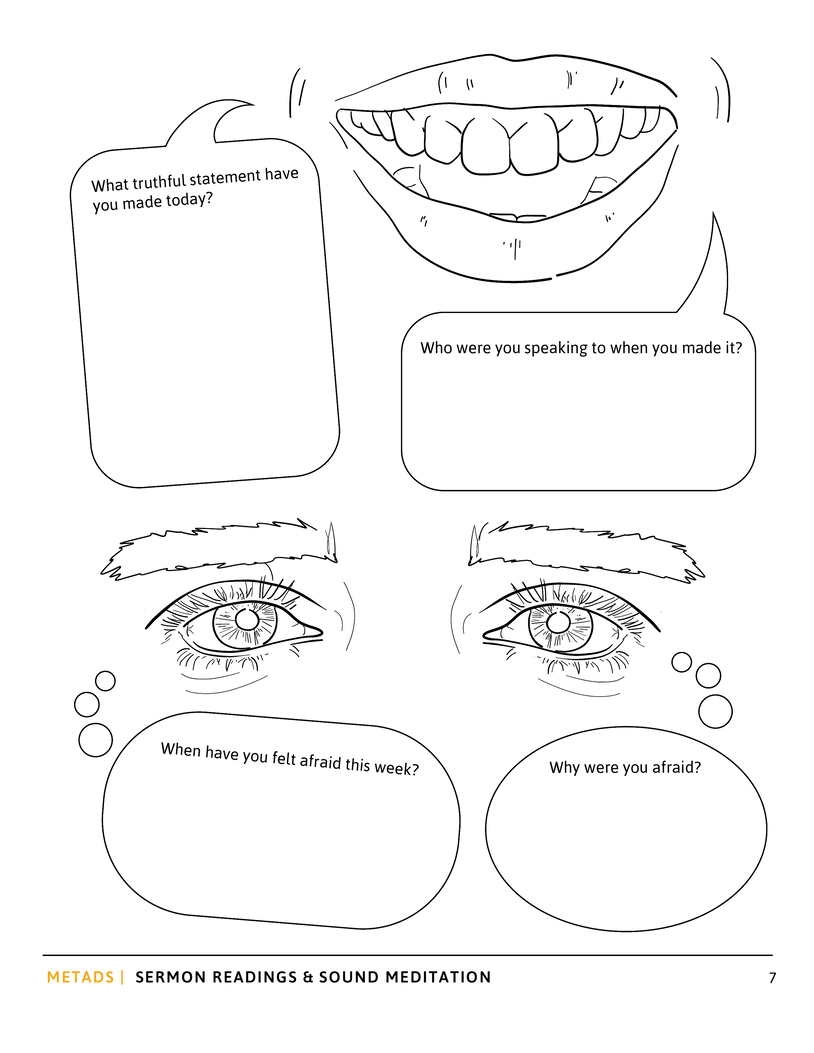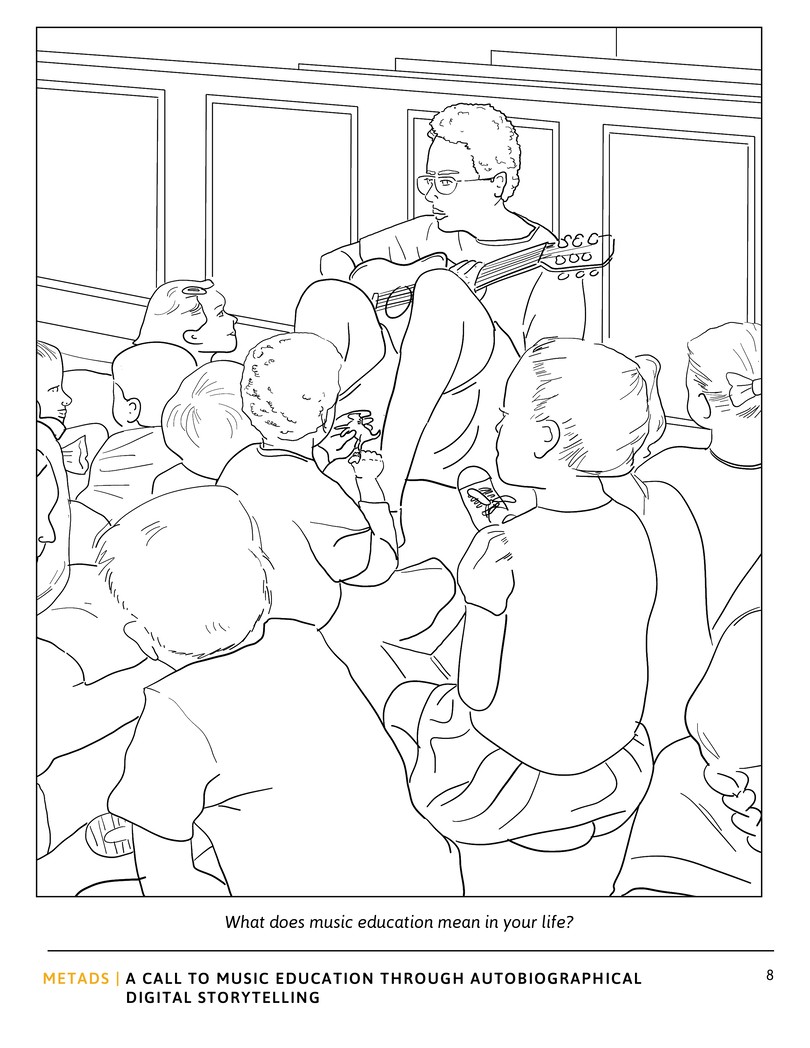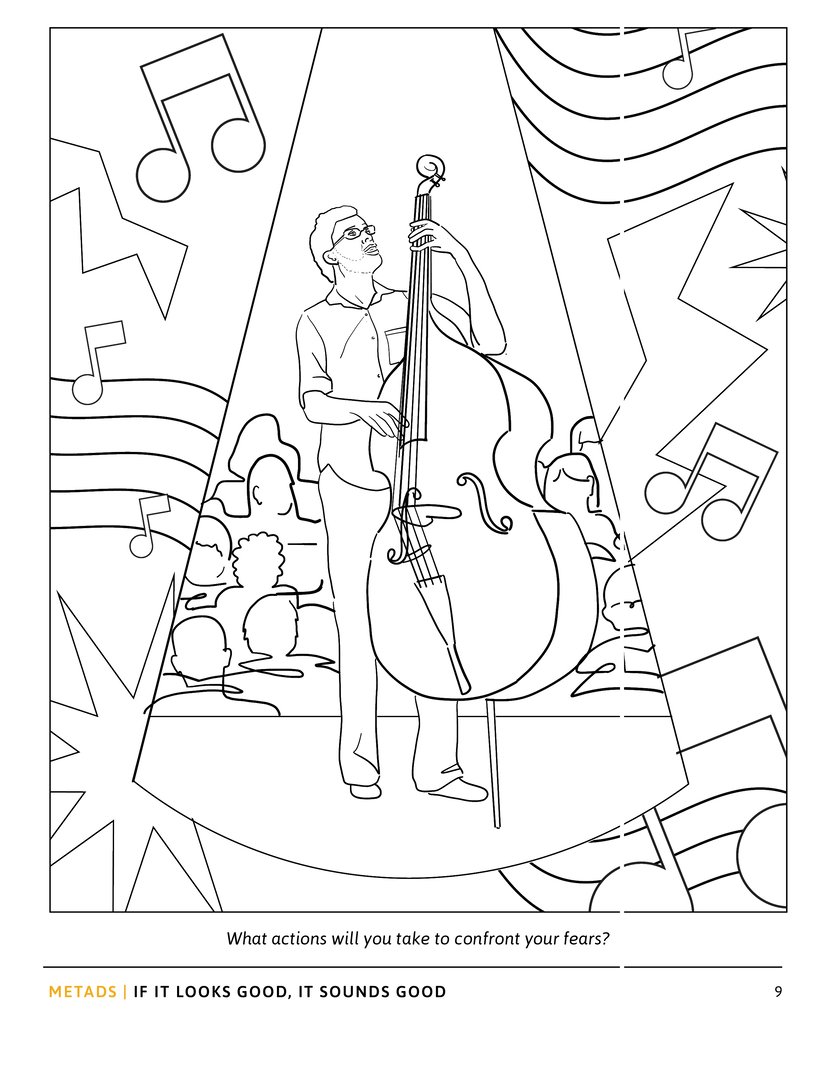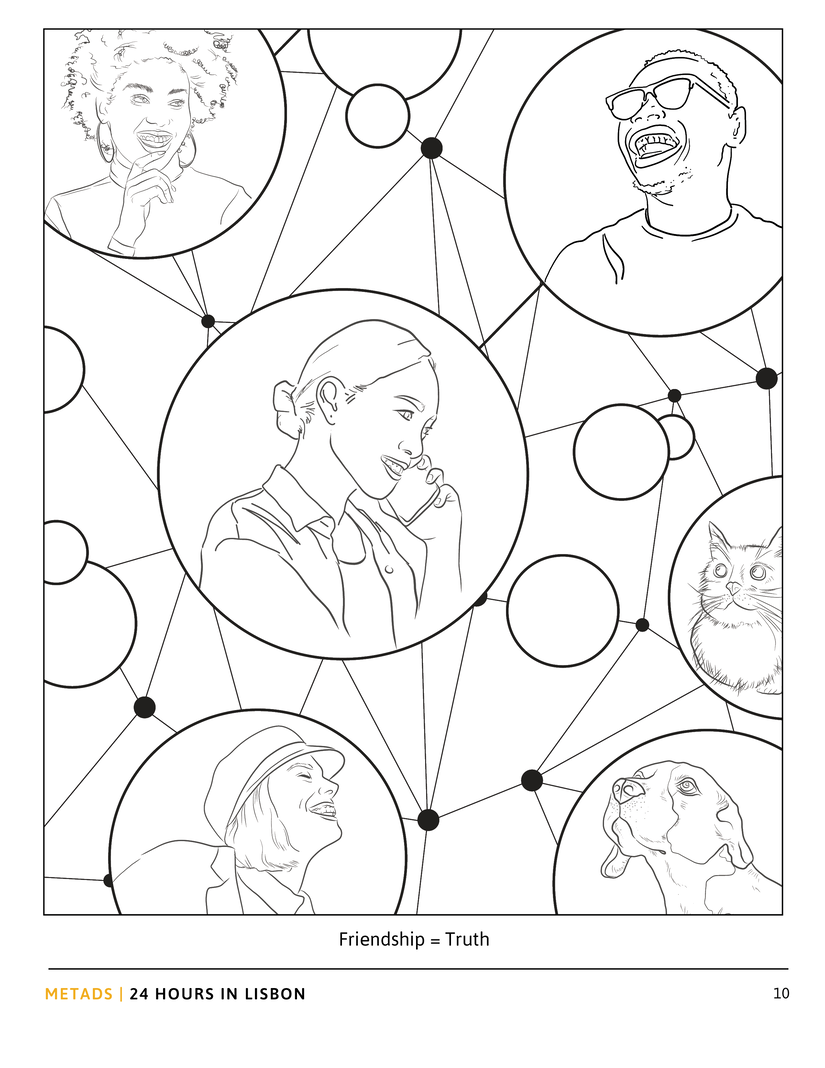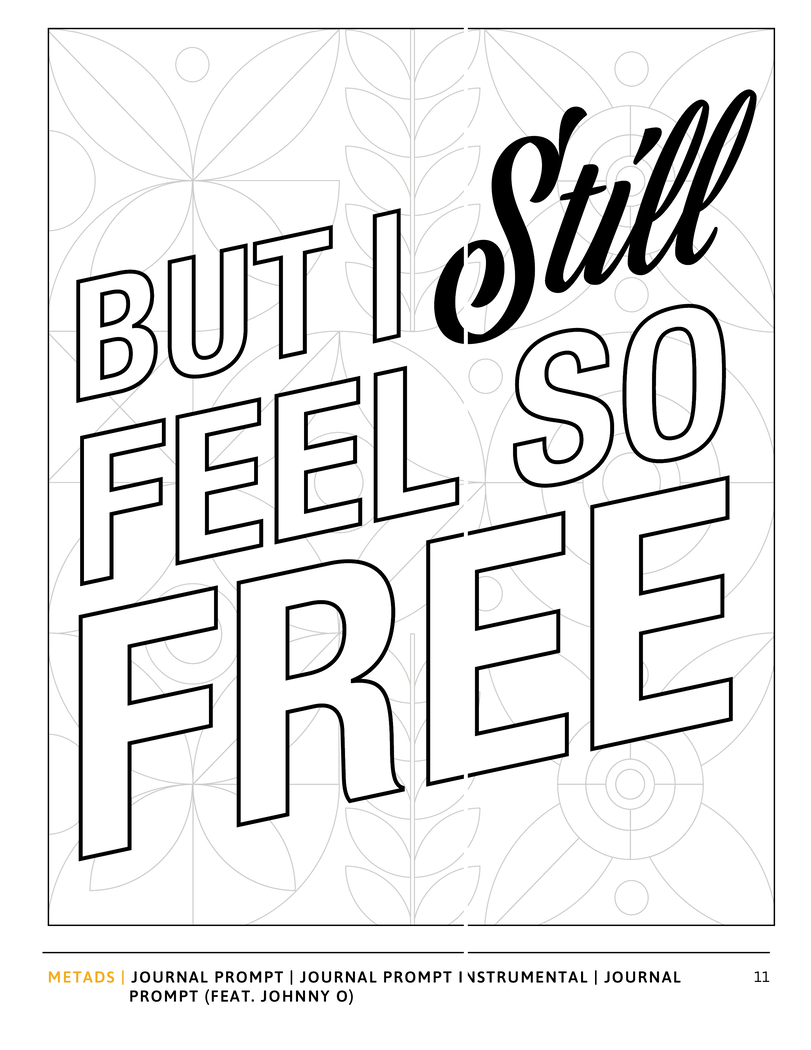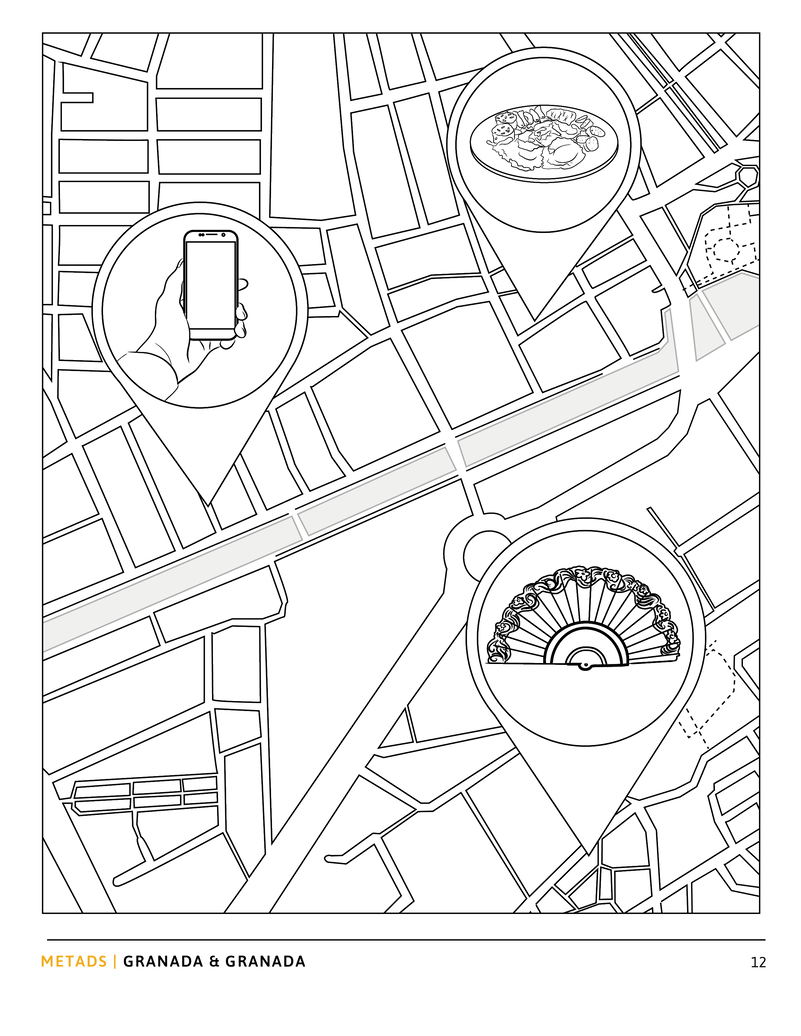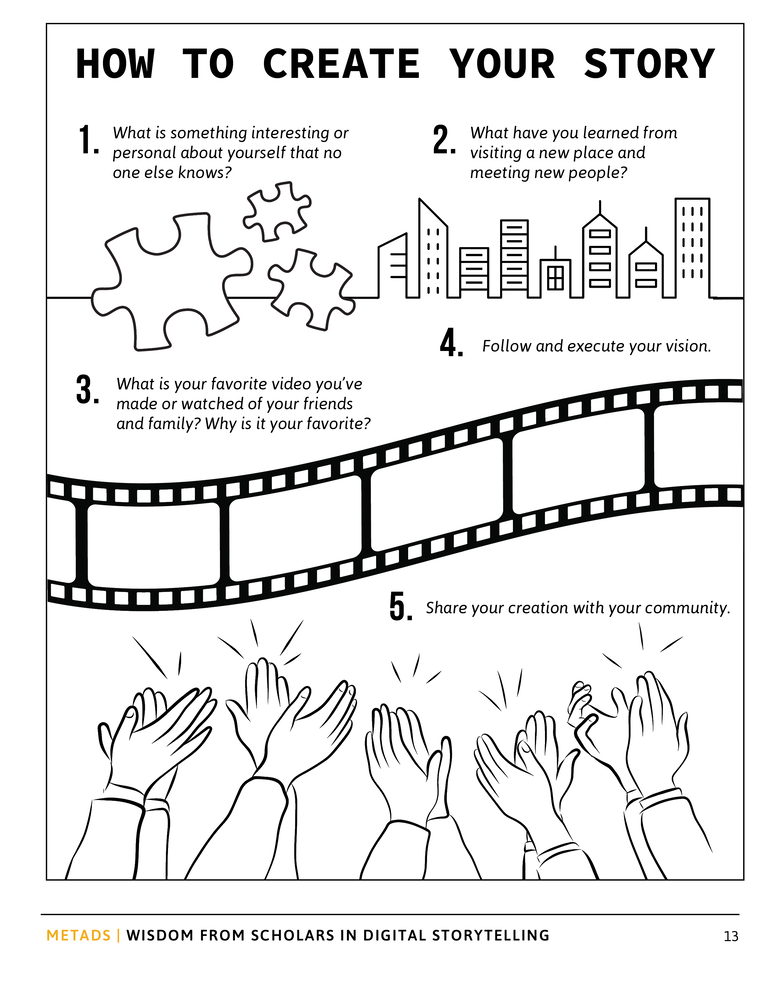DEAR READER,
- FOLLOW THE ARROWS FROM LEFT TO RIGHT & UP AND DOWN TO THROUGHLY ENGAGE THE TEXT, AUDIO AND VISUALS OF METADS.
- CLICK ON THE ILLUSTRATIONS FROM THE VISUAL GUIDE TO DISCOVER A FOOTNOTE WHICH CONTAINS THE AUDIO SERMON/STORY TEXT.
- HOVER OVER AUDIO PLAYERS TO READ THE CORRESPONDING TRACK TITLES FOR EACH AUDIO SERMON STORY. CLICK ON THE AUDIO PLAYERS TO LISTEN TO THE STORY OF METADS.
- HYPERLINKS WILL TAKE YOU TO EXTERNAL SITES TO LEARN MORE ABOUT AN EXHIBITION FEATURING METADS AND ABOUT ITS VISUAL AESTHETIC.
- THE ESSENTIAL QUESTIONS AT THE END OF THE PRESENTATION ARE A REFLECTION ON METADS' UNIQUE ENGAGEMENT WITH THE QUESTIONS POSED BY THE 14TH SAR INTERNATIONAL CONFERENCE ON ARTISTIC RESEARCH.
March 30, 2022
Jeffrey:
"Describe your use of digital technology within METADS."
Lauren:
"For the METADS visual guide, I use a few different softwares to bring the book to life. I used an array of Adobe programs to bring the cover art to life, including editing a scanned watercolor in Adobe Photoshop and Adobe Illustrator for the text. I use Indesign for the METADS Visual Guide which helps keep the layout and pages consistent. Then I draw the illustratrations on Adobe Fresco and clean up the vector lines in Adobe Illustrator."
Jeffrey: "As a visual artist, how has it been for you working on this interdisciplinary project that engages music/sound and storytelling?"
Lauren: "METADS is such a unique and well-crafted story and I've enjoyed interpreting the intricacies of the digital album into a visual language to help listeners engage with it even further. Creating the visual guide has been an exciting challenge since METADS is all about a series of individual experiences that so many can relate to. I’ve had so much fun to find exactly the right illustration or graphic to show those universal connections."
What does it mean to create something new?
METADS becomes an invention and/or innovation when we critically review the quality of our relationships in music education. This requires our individual confrontations with fear and our ability to tell the truth within our musical relationships. It is an act of courage to examine how we have treated others in our music education communities both outside and within musical spaces. This act of courage will maintain the forward motion and utility of music education in our culture beyond music as mere entertainment.
Suggested Reading:
Beghin,Tom (Orpheus Institute, Ghent, Paulo de Assis (Orpheus Institute, Ghent), et al. Artistic Research In Music: Discipline and Resistance. "Searching for Depth in the Flat World: Art, Research, and Institutions". Esa Kirkkopelto - University of the Arts Helsinki. Leuven University Press, 2017
What is "Music Education Through Autobiographical Digital Storytelling" as a matter of aristic research?
What is artistic research responsible for?
Artistic research in METADS is the pursuit of how to share musical experiences & memories as personal/autobiographical digital stories. It is an endeavor not solely dependent upon musical aptitude or performance and is more critical than the mere appreciation of music. It is one's ability to understand how music can assist relational development with others both inside and outside music education communities. It should lead to conversations about how to build an emotionally confident relationship with music that supports the telling of rare and important truths about our lives and interdependencies as musicans. Artistic research in METADS should be responsible for generating this type of specific growth in music education.
Suggested Listening & Reading:
Adrian Piper. What, Exactly, is the Idea of Artistic Research? Accessed June 27, 2016. https://www.youtube.com/watch?v=tYZLg9-x3g4
Barnes, Craig M. The Pastor as Minor Poet: Texts and Subtexts in Ministerial Life. “The Subtext of Human Life” & “The Subtext of the Poet”. Wm. B. Eerdmans Publishing Co. Grand Rapids. 2009
Long, Thomas. The Witness of Preaching. Third Edition. "Introduction" & "What Does it Mean to Preach?". Westminister John Knox Press, Louisville, KY. 2016
What is the right time and form?
Autobiographical digital storytelling is a useful approach to artistic research because it reminds us to respond responsibly to a world that is engaging in storytelling through digital media platforms. This inevitably leads us to a discussion on the utility of the cell phone and its function for telling stories both publically and privately. Digital stories can be curated as voice memos, videos, music and text documents. These digital archives can last forever on our devices as emails or in digital clouds/hardrives. Our periodic personal engagement with these materials can remind us of both private & public memories that can be reflected on anew. How and when we choose to do this within our music education journey is a reflection of our ethical/moral fabric in relationships that are greatly affected by technology. This should put us in a reflection about our cooperative decisions and the temporality of our relationshps when making music. In the form of a question, "what are we doing constructively with our musical experiences both privately and publicly in the digital age?"
Suggested Viewing & Reading:
George Saunders On Story. Accessed on April 12, 2016. https://youtu.be/1-1xNNrABw8
Gregori-Signes, Carmina & Brigido-Corachan, A.M. Appraising Digital Storytelling Across Educational Contexts. "Personal storytelling in the digital society" - Jose Luis Rodriguez-Illera. Universitat de Valencia. 2014.
Ken Burns On Story. Accessed on April 12, 2016. https://youtu.be/VlZYgPllKNU
The Center for Digital Storytelling. Accessed on April 12, 2016. https://www.storycenter.org/
WHAT KIND OF ARTISTIC RESEARCH PRACTICES WOULD ENABLE US TO REFLECT AND RESPOND EFFECTIVELY TO THE URGENCIES OF OUR MOMENT?
METADS seeks to answer this question for the music student & teacher leveraging storytelling about the self (personal/autobiographical) within musical environments that are digitally generated and disseminated through the use of the cell phone or other capable digital devices for text, image/video, and audio/music. There is nothing more urgent to us as musicians and artists than to have edifying relationships that help us confront interpersonal fear concerning what we have done or left undone in our creative lives from a human relational perspective. This work cannot be divorced from our understanding of ourselves both in the flesh and in the digital realm. It is an artistic research practice to reflect on and carefully document how we have treated others within varied musical/creative environments and what we've learned as a result. The telling of your personal story both deliberately and carefully within the arts will bring about a change of outlook and hopefully more postive relationships by way of constructive (rare & important) truth-telling.
Music educators need to decide on and articulate what is appropriate professional practice in music education through the articulation of these stories that come to life through social media and various digital production methods. The wide range of lessons that can be learned, archived and disseminated may inspire the most critical artistic research.
Suggested Reading:
MUSIC EDUCATION THROUGH AUTOBIOGRAPHICAL DIGITAL STORYTELLING (METADS) - 14th Society for Artistic Research (SAR) Conference, Norwegian University of Science and Technology (NTNU) - APRIL 21, 2023
Post-Presentation Notes & Additional Resources
1. Digital storytelling, especially in its autobiographical/personal form, can be applied as a methodology for artistic research in order to examine one's self through the use of digital tools. Below is a helpful definition of digital storytelling I encountered in my research. The page that hosted this definition seems to hosts different content now, but the definition is still applicable to METADS:
Information Age Education. “Digital Storytelling”. Accessed on February 22, 2016. http://i-a-e.org/articles/46-feature-articles/50-digital-storytelling.html
"The process by which people of all ages and experiences share with others stories of their lives or creative imagination, using words, sound effects, field recordings, and music. Hypertext environments facilitate the interactive story in which the "reader" chooses optional paths to explore. Web-based media facilitate not only stories with words, but also movies, stills, sounds, and graphics.”
2. The following is a useful at-a glance view of autobiographical digital storytelling. This was the document I based my interviews on with music students & teachers in digital storytelling during my preparation for METADS:
Cobbold, Jeffrey. A Short Guide To Autobiographical Digital Storytelling. Accessed April 1, 2017. https://docs.google.com/document/d/1VbZPgneVevwscKCfb08EshSHybHNcWuXzGAOohL2QXA/edit?usp=drivesdk
3. Although it does not appear within METADS, the following Biblical Scripture is an important subtext for this project. Please see my short exegetical paper and Bible study on Genesis 11:1-9 written during my seminary studies. It focuses on the role of mutuality in relationships, which is very pertinent to the story of METADS: https://docs.google.com/document/d/1RuWFOpSnFkCDZOobdrU_dJRWOk3Vp2KlnaT0Z_pW6oc/edit?usp=sharing
4. A question about archival practices was brought up during our discussion time. I recommended storing digital photos in the application Google Photos. This application can be set up to send you nostalgic reminders about past events and relationships. Google photos organizes this using the metadata from each photo/video. This makes personal storytelling a bit more accessible when we can discover through automation what we were doing or documenting on a particular day.
5. It was asked where METADS categorized as a creative expression, either as art, music, or storytelling? It is important to understand that METADS and my preceding digital storytelling master's thesis project, Becoming a Digital Humanist, were both "academic and creative projects related to the study and practice of contemporary music...related to contemporary music and may include performances, compositions, scores for films or other media, technology, business, festivals, music therapy, music education, music research, archival work, music history..." as per the Berklee College of Music (Valencia) 2015/2016 Graduate Studies Bulletin. I took these words quite literally and focused on making a music-inspired project that had its own unique musical features. This general approach has led to my work as a multimedia artist related to the practice of music, which has focus on personal/autobiographical digital storytelling as a methodology.
6. It was asked if I still teach music since METADS is dedicated to my former students from 2004 - 2020. The last time I taught was online through Zoom for a local library during the pandemic. The topic was on journaling and was inspired by the METADS' music track, "JOURNAL PROMPT". Please see the following curriculum and audio excerpts of my online teaching on this topic:
https://jeffreycobbold.com/journal-prompt-moments
7. As advice for those interested in utilizing digital storytelling in their artistic research practice I would share the wisdom offered to me by Professor Robert Brookey at Ball State University, which is to understand one's self as having a core discipline that digital storytelling can assist with or otherwise strengthen. Each artistic researcher will have a different application of personal/autobiographical digital storytelling in their work. METADS hopefully introduces you to the benefits of this tool within an artistic research setting.
8. The following digital story from the StoryCenter is one that made a great impression on me and inspired my decision to incorporate this tool within my artistic research: Please watch, "Daddy's Girl" by Deidre Johnson, https://youtu.be/ucJF6GlUwCc
StoryCorps is also another important digital storytelling organization with very poignant personal digital stories: You can listen on SoundCloud: https://soundcloud.com/storycorps
9. You can listen to METADS in its entirety on SoundCloud & Bandcamp:
https://soundcloud.com/jeffreycobbold/sets/metads
https://jeffreycobbold.bandcamp.com/album/metads
A Final Thought
In this video I mentioned what could be the future of METADS as a public presentation. This would include delivering the sermon audio to a live audience of people along with commentary from myself. The visual guide is also intended as a coloring book and would benefit from live coloring or videos that could be presented in a public presentation. Having the visual guide connected to its corresponding sound art and experimental music in public presentation would greatly strengthen the impact of the METADS story.
Video credit: Maria Aamand
